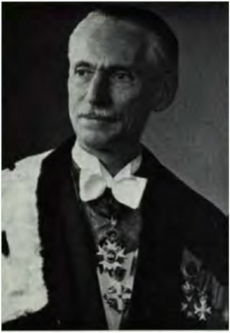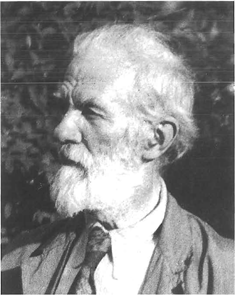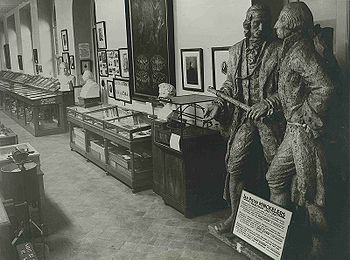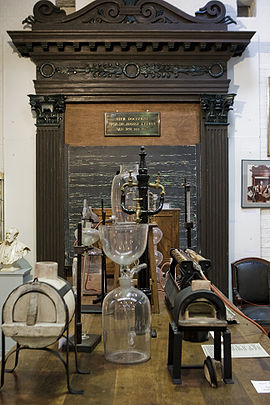Museum of the History of Science
Institution founded in 1948 in Ghent and dedicated to exhibiting the scientific academic heritage of Ghent University.
History
The Ghent chemist Jan Gillis was the first to suggest the creation of a science history museum at a meeting of the MacLeod Fund in 1938. The museum, Gillis said, would bear the name of the biologist and passionate science historian Julius MacLeod in his honour. The idea, however, found no fertile ground at a time when interest in the history of science at universities was generally waning and budgets were tight.[1]
With the outbreak of war, the MacLeod Fund went into hibernation.
It was mainly Gillis and his colleague Albert Van de Velde who managed to rekindle interest in scientific history shortly before and just after the Second World War.[2]
In 1941, through Van de Velde's efforts, a Standing Commission for the History of Sciences was established within the Royal Flemish Academy.
Again, it was Gillis who put the establishment of a museum on the committee agenda that same year. The 'Commission for the preparation of a Museum of Flemish Science' that was set up in response to this, included besides Gillis also Henri Schouteden, Walter Robyns, Paul van Oye and of course Van de Velde.[3]
Inspiration for the future museum was found at the recently founded Nederlandsch Historisch Natuurwetenschappelijk Museum and at the Museum der Vlaamsche Letterkunde.[4]
The members of the founding committee devoted themselves during the remainder of the war years to tracing, describing and making an inventory of potential collection items - instruments, personal objects, manuscripts and other relics of prominent Flemish scholars from the past. By the end of the war, a "paper" museum had taken shape, consisting of hundreds of index cards. This pre-modern museum was explicitly Flemish in character. On the index cards was neatly indicated whether the scholar was "Flemish-loving" and if so, to what degree, or "hostile to the Flemish cause" - but even the latter was granted a place in the museum, "out of historical interest". After the war, the necessary funds for a real museum were unfortunately lacking.[5]
It is not clear whether a lack of funds was the cause, but it seemed that the Permanent Committee, in the person of Van de Velde, was now setting its sights on another player. After three years of lobbying his contacts in the Ghent city council, Van de Velde did indeed get the result he was hoping for: in 1948, the council established a new municipal "Museum for the History of Science". It was housed in a room of the Bijloke, where the pieces of the Museum of Antiquities were also displayed. The members of the perpetual committee were appointed to the management board.[6]
From 1961 onwards, Ghent University made a commitment to contribute to the city for maintenance and staff costs. With its establishment, the Ghent city council not only fulfilled the dream of Gillis and Van de Velde, but also, and primarily, the wishes of its own citizenry. The people of Ghent were curious about the scientific collections of the university. At the request of the city, the faculties therefore opened their collections of demonstration models and instrument cabinets to the general public once a year. These objects were now made publicly accessible for the first time in an attractively arranged museum.[7]
As an urban and "university" museum, the new institution did deviate from the initial nationally-oriented, Flemish set-up of the Permanent Commission. Instead of focusing on relics of leading Flemish scientists, the emphasis now lay on the historical development of the various scientific disciplines. This was illustrated by instruments and other objects, which, moreover, were largely brought in from Ghent University. Nevertheless, a number of core elements of the original idea were retained. For instance, in the various disciplinary sections, the visitor could marvel at busts and larger-than-life statues of Flemish scholars who had been leading figures in their respective disciplines.[8]
Van de Velde, naturally, became the museum's first "director" (chairman). He fulfilled his task to such an extent that the museum was bursting at the seams after just one year. Something that was even more aggrevated by the fact that after the Second World War, scientific equipment became outdated more and more quickly. This meant that many written-off instruments and obsolete demonstration models were thrown away or dismantled, but many ended up in the exhibition rooms or the museum's depot..[9]
The three rooms in the Museum of Fine Arts, to which the collection was moved in 1950, initially seemed oversized. But after six years, the situation was already untenable, according to Van Oye. "The objects had to be stacked on top of each other, all corners and sides were [...] crammed." Critics called the museum a "junkyard".[10]
Influenced by Van Oye and others, who in the meantime had succeeded Jean Van de Velde (son of) as director, the museum passed into the hands of the university in 1964, which from then on bore all the costs. A new, spacious location was found for the collection in a university building on Korte Meer (no. 9). A bust of the founder Van de Velde was placed at the entrance to the building.[11] On 29 October 1965 it was solemnly inaugurated. From now on, the museum would explicitly play a supporting educational role for the History of Science course. It also organised lectures and exhibitions. In the meantime, collecting continued. During the major construction and relocation episodes at UGhent in the 1960s and 1970s, the museum was able to save several instrument cabinets from the garbage container.
In 1994, the museum moved once again, this time to the De Sterre science campus, where the collection could be housed in former military hangars. In the meantime, the collection continued to expand, including computers and even a particle accelerator. The primary focus remained on the instruments. Even today, however, key elements of Gillis and Van de Velde's original concept seem to have been preserved. However, without extending the Flemish theme, efforts were made to create or acquire collections around distinguished scientists such as: Joseph Plateau, Leo Baekeland en August Kekulé. Who got a central and distinct place in the museum.
Directors
- Albert Van de Velde (1948-1956)
- Jean Van de Velde (1956-1961)
- Paul van Oye (1961-1964/5?)
- Jan-Baptiste Quintyn (1964/5-1984 )
- Frans Lox (1985-1993)
- Maurice Dorikens (1995-2001)
- Jozef Uyttenhove (2001-2006)
- Danny Segers (2006-)
Location
The museum for the history of science has today merged into the GUM (Ghent University Museum: Forum for science, doubt & art) and is located at Ledeganckstraat 35, 9000 Ghent.
Website
- old website: www.sciencemuseum.ugent.be
- current website GUM: www.gum.gent.
Bibliography
- "Verslagen van de Bestendige Commissie voor de Geschiedenis van de Wetenschappen", in: Koninklijke Vlaamse Academie voor Wetenschappen, Letteren en Schoone kunsten van België Jaarboek, (1942-1948).
- Van de Velde, Albert, "Het museum voor de geschiedenis der wetenschappen", in: Mededelingen van de Koninklijke vlaamse Academie voor Wetenschappen, Letteren en Schone Kunsten van België : Klasse der Wetenschappen, 13 (1951), nr 4.
- Timmermans, Jean, Van Oye, Paul en Rooseboom, Maria, Openbare hulde aan Professor Albert J.J. van de Velde, stichter van het Museum voor de Geschiedenis der Wetenschappen, op dinsdag 9 April 1957 te 18 uur in de erezaal van het Museum voor Schone Kunsten te Gent, Ghent, 1958.
- 'Inwijdingsplechtigheid van de nieuwe installatie op 29 october 1965', in: Sartonia, 1 (1966), 1-16.
- Van Oye, Paul, ‘Inwijding van de nieuwe installatie van het museum voor de geschiedenis van de wetenschappen op 29-11-1965’, in: De Brug, 10 (1966), nr. 1, 9-21.
- Gillis, Jan "Van de Velde Albert Jacques Joseph", in: Nationaal Biografisch Woordenboek, 5 (1972), kol. 915-918.
- Dorikens, Maurice, ‘Het museum voor de geschiedenis van de wetenschappen van de universiteit Gent’, in: Scientiarium Historia, 21 (1995) nr.2, 103-111.
- Segers, Danny, “Geschiedenis van ‘het Museum voor de Geschiedenis van de wetenschappen’”, in: Museum voor de Geschiedenis van de wetenschappen. Catalogus met achtergrondinformatie bij de jubileumtentoonstelling, Gent, 2006.
- Wautiers, Kristel en Segers, Danny, “De professoren A.J.J. Van de Velde en P. Van Oye en de oprichting van het Museum voor de Geschiedenis van de Wetenschappen”, onuitgegeven paper, Studiedag Sarton en de Belgische Wetenschapsgeschiedenis, Paleis der Academiën Brussel, 13 november 2013.
- Danniau, Fien, "Museum voor de Geschiedenis van de Wetenschappen", op: Ugentmemorie (accessed 24-09-2015).
Notes
- ↑ In 1939, however, an exhibition on MacLeod was organised. Archief Museum voor de Geschiedenis van de Wetenschappen, MacLeod Fonds, Verslagboek MacLeod Fonds, s dd. 24.11.1938, "Verslag van de bestuurszitting van het Archief ‘MacLeod Fonds’" and Maurice Dorikens, ‘Het museum voor de geschiedenis van de wetenschappen van de Universiteit Gent’, in: Scientiarium Historia, 21, (1995), nr. 2, 103.
- ↑ Vanpaemel, Geert, "Bijlage Wetenschapsgeschiedenis in België" in: Halleux, Robert, Opsomer, Carmélia en Vandersmissen, Jan, 1998, Brussel, 430.
- ↑ From 1942, the committee preferred 'Vlaamsch museum voor de wetenschap' [Flemish museum for science] as opposed to the ‘Commissie ter voorbereiding van een Museum der Vlaamsche Wetenschap’ ['Commission for the preparation of a Museum of Flemish Science']. Bestendige Commissie voor de Geschiedenis der Wetenschappen in Vlaamsch-België – Verslag over 1942, in: Koninklijke Vlaamse Academie voor Wetenschappen, Letteren en Schoone kunsten van België Jaarboek, 4 (1942), 135.
- ↑ The current 'Letterenhuis' in Antwerp.
- ↑ Koninklijke Vlaamse Academie voor Wetenschappen, Letteren en Schoone kunsten van België Jaarboek, 3 (1941), 44-53 en 212-215 en 4 (1942), 130-151.
- ↑ Municipal decision of 11 March 1946. As documented in: Koninklijke Vlaamse Academie voor Wetenschappen, Letteren en Schoone kunsten van België Jaarboek, 8 (1946), 171-172.
- ↑ Danniau, Fien, Museum voor de Geschiedenis van de Wetenschappen, on: Ugentmemorie (accessed 24-09-2015).
- ↑ Unfortunately, an inventory of the collection from this period does not exist, but the photos of the museum in the period 1950-1963 give good indications of the museum's set-up.
- ↑ Danniau, Fien, Museum voor de Geschiedenis van de Wetenschappen, on: Ugentmemorie (accessed 24-09-2015).
- ↑ Paul Van Oye, ‘Inwijding van de nieuwe installatie van het museum voor de geschiedenis van de wetenschappen op 29-11-1965’, in: De Brug, 10 (1966), nr. 1, 10.
- ↑ It was a cast of a bronze sculpture by Geo Verbanck (1954), which is in the museum's depot. Gillis, Jan "Van de Velde Albert Jacques Joseph", in: Nationaal Biografisch Woordenboek, 5 (1972), Brussels, kol. 918.



